

March 11, 2011
**We woke up to some horrible news about the Earthquake and subsequent Tsunami that struck Japan, and then threatened the Hawaiian Island and West Coast of the U.S. I taught the Intro to Oceanography course at USNA, and 2 of the core objectives are introducing the student’s to earthquakes and tsunamis. I hope that all those I taught were able to follow what was going on with a better understanding of the physical scientific processes that were taking place. The video and destruction were frightening to watch and my prayers are with the Japanese people to give them strength during these difficult times.**
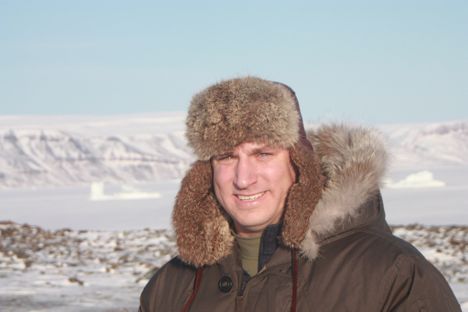
LCDR John Woods participates in the Arctic 2011 campaign of NASA’s Operation IceBridge mission in Thule, Greenland. Image is courtesy of John Woods.
Since the P-3 will not arrive until Monday we took the opportunity to take in some of the sights around base. Thule Air Base is the U.S. Armed Forces’ northernmost installation, located 750 miles north of the Arctic Circle. We were issued Arctic Gear the day before, which consists of a VERY warm down parka, and other essential clothing that you need to survive the minus 5 degree Fahrenheit air temperatures and even colder wind chills. Unfortunately the base was in a weather warning when we woke up which meant no off base travel was authorized. However, after lunch the weather warning was lifted. Before you are allowed to travel off base you must visit a building to check out a radio, and fill out a trip plan with your personal info, and planned return time. There was quite the character in there. He was a Emergency Management worker from Denmark telling us about recent polar bear sightings and the possibility of finding some Inuit Seal hunters in nearby Dundas Village. He was joking (we think) about which of us could run faster, stating that whoever was slowest should be a distraction to the hungry polar bear, and the faster runner should survive!
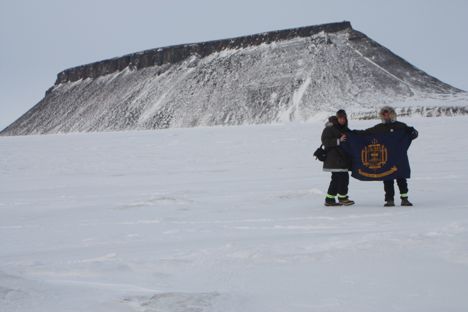
LCDR John Woods and MIDN Eric Brugler stand in front of Mt. Dundas in Thule, Greenland. Credit: John Woods
We took a taxi (more about them later) to edge of Northstar Bay and began our trek across the sea ice towards Dundas Village. The village looked only a mile or so away, however, all features seem closer than they really are here due to extraordinary clear atmosphere, it is quite the optical illusion. We got varying reports from folks how long it would take us to walk across the ice, from 1-2 hours. So off we went.

The clear Arctic atmosphere makes Dundas Village in Thule, Greenland, appear just a short distance away. Credit: John Woods
The wind was only about 10 or 15 knots, but right in our faces, which made any exposed skin very uncomfortable. We had our facemasks pulled up covering every last portion as we followed recent dog sled tracks towards the hunting village. When we arrived (approximately 45 minutes) it was eerily quiet, as we hadn’t noticed any motion during our walk across the frozen bay. There were no signs of recent activity, minus LOTS of sled dog droppings, and a polar bear paw, with its fur and claws ripped from it. We found it strangely odd that just this one paw was left behind with no other signs of anything, so we took a few photos, and put it back where we found it.
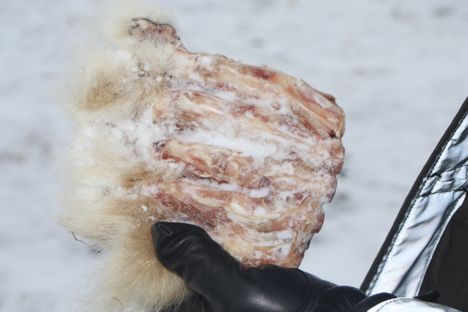
LCDR John Woods and MIDN Eric Brugler find a polar bear paw during their Arctic excursion. Credit: John Woods
We explored the dozen or so huts, and decided to climb the small incline past the village to see what was on the other side. What a site! Another frozen body of water was in front of us, but this time three large Icebergs were within walking distance. We decided to hike out to the nearest one and got some good photos climbing to the top. At this point we were outside for about two and half hours, and we graciously took the offer of a Danish couple, who was out for a sightseeing drive, for a ride back to base. They were very pleasant, and shared all sorts of neat information about what it is like to live in Greenland. He was a firefighter and EMT, and has been here for over three years and she has been here just over a year and was a physical therapist on base. They brought us up towards the BMEWS (Ballistic Missile Early Warning System more on this in a later post), and to some great vantage points over looking the Wolstenholme fjord. This is the only place in the world where four glaciers combine into one fjord, it was an amazing view!
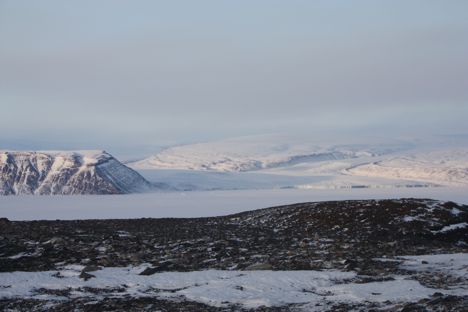
Woods and Brugler hike by a fjord in Thule, Greenland. Credit: John Woods
On the way back to base, we stopped in one of the many Survival huts, to take a look around. These are all over the roads off base, and on base in case of a sudden storm that can create impassable white out conditions. It was an exciting day, filled with adventures that you just cannot experience in many other places on Earth!
March 10, 2011
LCDR John Woods is a Meteorology and Oceanography Officer (METOC) currently teaching in the Oceanography Department at the United States Naval Academy (USNA). He is part of the Sea Ice Thickness Observation team joined NASA’s Operation IceBridge mission in the field for the Arctic 2011 campaign. (OIB 2011).
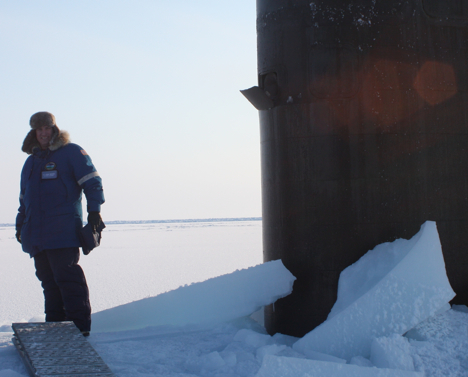
LCDR John Woods stands on the USS Annapolis during ICEX 2009, 200 miles north of Alaska. Credit: LCDR Woods
Most midshipmen at USNA spend their spring breaks in some warm, tropical location. But I like to introduce students to an environment unknown to many, the Arctic. These next few weeks I will be living at Thule Air Force Base on the Northwest coast of Greenland, flying in NASA P-3 aircraft, observing the collection of data of Arctic Sea Ice. I have a senior research student along with me, who will be finishing up his project on looking at sea ice observation techniques with some “in-field” experience.
How did we get here? About two months ago, my attempts to participate in a Navy Ice Camp off the North Slope of Alaska, to which I brought two students in 2009, were not looking so promising, so I began looking for another mission to the Arctic. A good colleague of mine, Jackie Richter Menge, pointed me towards the Sea Ice Observing Team (of which she is the lead) meeting at NASA’s Goddard Space Flight Center right down the road from Annapolis, in Greenbelt, Md. I had never heard of IceBridge before this meeting, but left with the prospect that a student and myself would be able to participate in P-3 overflights of the Arctic. Well, after weeks of thorough coordination with multiple parties and agencies (Navy, NASA, NOAA), we found approval and funding for our trip.
MIDN Brugler is finishing up his USNA Senior Research project working with me on sea ice thickness measurement studies. He has been busy for two semesters reading papers and looking at data, but my goal was to get him into the field to observe the collection techniques he has spent so much time reading about. It was a big sacrifice to give up his final spring break, but I think he is excited about this once-in-a-lifetime experience.
So, our trip began at Baltimore Washington International Airport just a short 30 minute drive from my home. We piled our three children into the car, and my wife Anne drove Eric and I to the airport at 9 p.m. We showed up at the Military Airlift Command, to a fairly empty airport, and one of the easiest check-in process I have ever experienced traveling. We then searched out some food to wait for our 2 a.m. flight departure, and we ran into the rest of the party traveling to Thule with us. It was great linking up with the rest of the “first wave” of IceBridge team members. A majority of the team will be arriving via the P-3 aircraft next week on Monday. 2 a.m. arrived and we boarded the DC-8 chartered aircraft for the 5 hour and 45 minute flight due north to Greenland.
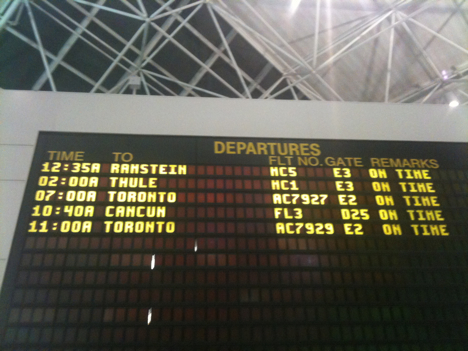
The departure flight board at BWI airport notes our 2 a.m. flight to Thule. Credit: LCDR Woods
The flight was comfortable, although a bit chilly at times. It was similar to a commercial airline, however, it was primarily a cargo mission, with most of the plane consisting of a large cargo hold and with only 30 seats situated towards the rear of the aircraft. I was able to sleep for some part of the flight (remember it was VERY early in the morning!) However, I was gratefully woken up by a strong beam of sunlight as the sun rose through the window across from me. This was a pleasant surprise, because as I looked out my window I saw a beautiful sight. Large sea ice floes creating a seascape like one I have never seen before. I began snapping pictures for the remainder of the flight. Each minute the area of ocean below us was constantly changing. It would be completely covered in ice, then only several floes. Large cracks or leads, different stages of ice formation, open water, icebergs, and even sea smoke (or low clouds) forming over the relatively warm ocean and VERY cold air above. It was truly breathtaking!
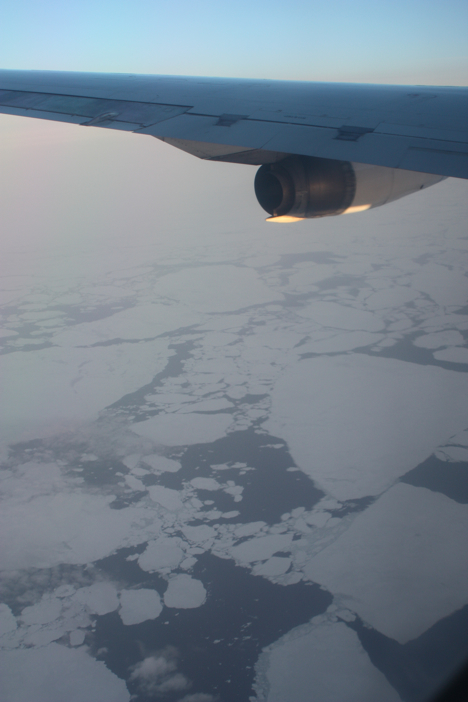
Large sea ice floes below are illuminated by the sunrise. Credit: LCDR Woods
We landed at approximately 9 a.m. local (a 1-hour time advance), to some more great scenery. Once the coastline of Greenland was spotted, we were already on final approach. This was another landscape that I have never experienced before. The Greenland Ice Sheet was directly below us, mountains went right to the ocean, glaciers flowing between peaks, ending in a field of broken up icebergs floating just offshore stuck in the ice. We were only over land for a few minutes before Thule Air Force Base was in sight. We rounded Mt. Dundas and landed smoothly on the white ice-covered runway. A short taxi to the terminal and we stepped out into the bone-chilling minus 25 degree weather. Instantly the moisture inside my nose froze. It was a very interesting feeling. Once inside the terminal, the base commander and his leadership team greeted us (as we were the only flight in for the week), and instantly made us feel at home. We are excited to explore the base and take in as much of the Thule experience while we have the opportunity before we get involved with the IceBridge flights scheduled to begin on Tuesday.
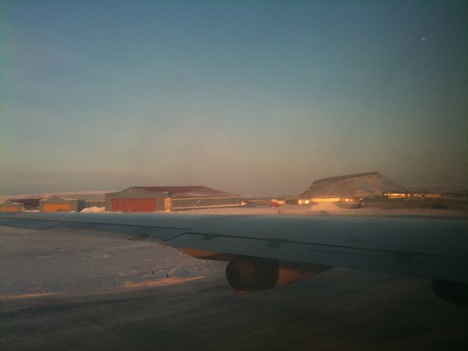
On the ground at Thule AFB, Mt. Dundas can be seen in the background, right-hand side. Credit: LCDR Woods
Test post.
Karsnoyarsk 56.2° N 92.5°E
9:10 p.m. Local Siberia; 9:10 a.m. next day EST
High 69F Low 42F Rain
We are back to where we started – in comfortable rooms at the Hotel for Scientists in Krasnoyarsk. We drove through the night and arrived here about 6:15 this morning. Even at that early hour, we were graciously greeted us and received keys to our rooms right away. After twenty two hours in the car, everyone was ready for a rest. So that’s what the day has been – a day of rest.
The ride home from camp went a lot smoother than the ride out. There was no car trouble at all. The Gorilla Glue on the windshield held up nicely, even at highway speed. All we had to do was gas up and drive. I think that the UAZ was kind of like an old horse ready to get back to the barn – it was a real quick ride.

All the Americans hung out at the hotel today. I slept until about 11 am, and then got a bite to eat. I feel pretty good, for only have slept about four hours in the last 48. There’s television here and I watched some of that. I don’t understand the language, but that’s okay – television is still entertaining.
After television, I thought I’d get on the internet and check in, to see what’s been going on in the world and catch up with work a bit. That was a struggle. I spent two hours trying to get a signal. I have it now, but it’s not that great, so I’m not well connected with the world.
Ross and Bruce and I also got together to talk about the trip, how things went, and discuss what could go better in the future. I guess you could call it a “hot wash”, but we just called it hanging out and talking. It’s a useful thing to do on a quiet day.
When I got in last night, I wanted to wash my face. I turned on the hot water faucet, wondering if the repairs to the system would be done, and if there would be any heat, or if it would be ice cold. It was not really either. The water was very slightly warm – slightly less than tepid, really. I was too tired for a cold shower, so I just toweled off quickly and went to bed, with the hope that the slight touch of warmth meant that repairs had been finished and that things would be better soon.
Sure enough, by this afternoon the hot water had been restored. What a treat! It’s always so nice to have a long, hot shower after expedition. On the other hand, a cold shower can feel really brutal when you’re so weary. I guess we are spoiled in America. We expect warm water all the time, on demand, at the turn of a faucet. But I can tell you from experience, that’s just not the case in many places. Warm water is a wonderful luxury.
I think I’ve always been in Krasnoyarsk when the hot water has been turned off. It seems that every expedition has been like this – no hot water either at the beginning or the end. We’ve never had to have cold water on both ends, however. Just the start or the end. It must take the government a week or so to make the repairs and perform maintenance, then they turn the water back on. I don’t know if the dates are scheduled in advance, so the locals know when they are going to get cold. But we never know before we get here. We just take whatever comes.
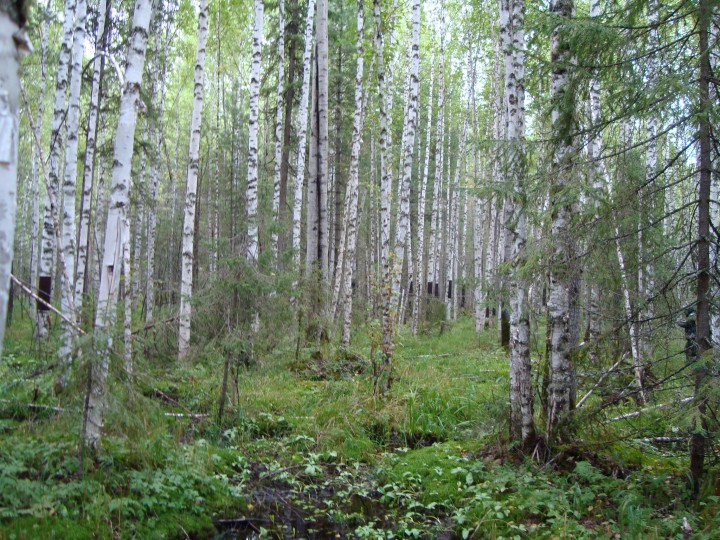
This is a pretty decent hotel, and it caters to foreigners with money. When the hot water is turned off, someone with money can still get a warm shower. The hotel has a private shower downstairs, with an on-demand electrically heated private hot water system. So it’s possible to get warm water, but you do have to pay extra for it. I’ve tried it before, and it’s not that wonderful. It’s just a trickle of water coming out of a wand-like thing so that you can run the water all over your body. For an American, it’s really a pretty sad shower. But, here, hot water is truly prized, and I’m sure it’s worth every ruble.
The plan from here is to get up tomorrow and go meet our Russian colleagues at the Sukachev Institute of Forest. We’ll talk about the trip, make sure everyone had the data they need, and wrap up the expedition. We’ll try to go out for a dinner together, to say good bye for this year. Then, the next morning, we’ll catch a flight from Krasnoyarsk to Moscow, then one to home. The Wild West Expedition of 2010 is just about complete.
It is early here, but the sun is down and a full moon has come up. I guess the Northern pike will be biting, for anyone willing to go to the river, since their new teeth should be in by this full moon. For me, it’s too far to go for fish soup. The pike can safely enjoy the moonlight and try their teeth on natural things, not lures. I’m still tired from the long ride, and ready to turn in for the night. Maybe another trip, in another year, we’ll meet the big pike with the fresh teeth.
Marinsk, 56.22 N 87.75 E
12:00 midnight Local Siberia; 12:00 Noon next day EST
High 74 F Low 69 F Rain
Today has been one long day of travel – and our day is not over yet. I’m calling from a little café in Marinsk, which is a town about 200 km east of Tomsk. It’s in the Kemerova Oblast and they tell me it sits the Kiya River. The drivers are buying big cups of coffee. Even though it is late and it is raining, our drivers say they still feel fresh and don’t want to quit. Our goal tonight is the Hotel for Scientists, in Krasnoyarsk.
We had planned to stop and camp for the night, but the sun set and rain started pouring down. It just didn’t make sense to go find a camp down a bad road in soaking rain, just to sleep for a few hours. We would have ended up soaked and cold. We decided it would be smarter to find a room for the night in one of the big towns, but that hasn’t worked out. Now we are only about 5 hours away from a real bed at our hotel. Our drivers are well-caffeinated and excited to drive on – so that’s fine with me. I just hope that the Hotel will be open and have our rooms ready at five in the morning, when we arrive.
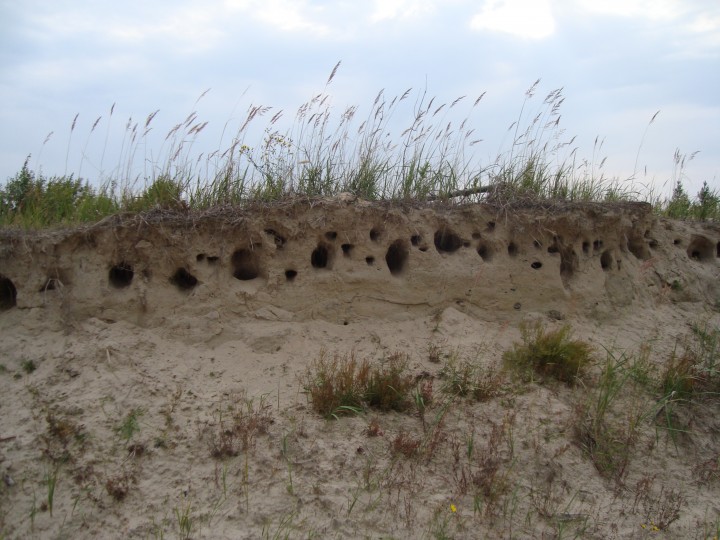
As we left our camp this morning, I discovered something pretty interesting. Next to the road there was a small sandy cliff, no more than three or four feet high. It had a bit of grass on top, but the face of the cliff was all packed sand. And the cliff was riddled with holes. I think cliff swallows are nesting here.
Slava confirmed that birds have used those nests, but he says they do not have pointed tails, like swallows do. I don’t have a bird book with me, but I think cliff swallows have less pointed tails than others. I’ll have to check this out when I get home. At any rate, the nests are right at eye level, and I went up to take a close look. No birds were to be seen. I guess they have finished nesting for the summer and have moved on. A sign of the winter that will soon be coming, no doubt.
Another sign of the times was the sunset last night. It was colorful, but it was as hazy as I’ve ever seen the sky in Siberia. Then when the moon came out, it looked veiled, too. It was almost full and it was bright, but the sky wasn’t clear. I believe we are seeing the effects of the smoke from all the fires that have been burning to our west. I can’t smell anything, and the air on our faces seems fresh enough. But haze from fires can travel high into the atmosphere, and travel across the world. So I think that is what we are seeing – a smoky Moon from those Russian fires.
I also learned that the camp we had last night had been used by geologists in years past. They were studying the area for oil and gas. So it’s all about using natural resources. The geologists will use resources in a different way than the people who collect birch bark, or the timber industry – or us, too, for that matter. We’re using natural resources, too, just in a different way. But our way also puts food our family table, just like the others who look to the forests for their work.
We climbed into our vehicles about 8:45 this morning, and haven’t stopped for very long – just for coffee and food. For me, it’s been a long day sitting, watching the countryside go by, and thinking.
It’s really been a privilege to be a part of this expedition and a part of the work we are doing. Here we sit, a group of Americans and Russians, together, in Siberia, working side by side. For most of my life, there was a Cold War going on. Russia and the US were bitter enemies, and tensions were high. Who would have ever guessed that we would now be here, with common friendships, common goals – and working together to better understand the Earth that we all inhabit?
It is also amazing to consider that work like this is being conducted all over the world. We’re not the only folks on expedition this week. There are lots of scientists in the field all the time, working hard and also having adventures. Science is a good career – and a worthwhile one. We look for knowledge, and knowledge is power, or so they say. I’m not very powerful, myself, but I do believe that sound knowledge paves the way for sound policy – and creates changes to make the world a better place.
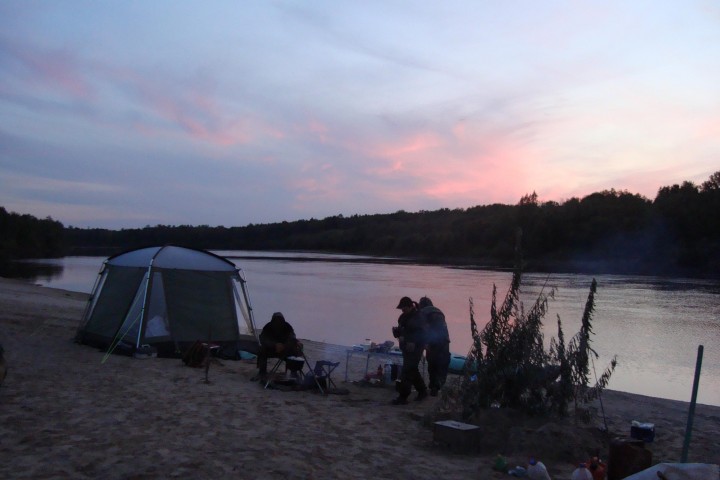
Road trips are good for talking, too. I found out that Pasha lived for a full two months in a forest much like the one we’ve been in. He was doing research on the biomass found in trunks, branches and needles of Siberian fir and Siberian spruce. I can’t imagine, myself, living in a forest camp that long, but then again, that’s what scientists sometimes have to do – and what they are lucky enough to do. Sometimes the forest is cold and wet and full of mosquitoes – but it’s sure a more interesting place than your average office.
Science is a pretty good profession for someone that likes to think, to travel, to question and be amazed, and to give something important back to the world as well. It’s a great community, one that fosters understanding among all people. I find it rewarding and comforting, as a senior scientist, to see the young faces on this expedition. These young Americans and Russians will continue the work that Slava and I have started well into the future, and will create their own studies. Our future here is in good hands.
As the miles went by, things got quiet, and I started thinking about the blog. If there was just one thing I’d like to get out to the readers – to students and scientists and policy makers and my family and friends, and, well – every one – what would it be?
After much thought, there’s one thing that keeps coming to mind. I do have one message today, for our readers. I want to tell them “Keep your wonder”.
Our world is an amazing place, with more depth, diversity and connection than can be imagined. If you look at this world with a true sense of wonder, then you will ask questions. From questions, comes study. And from study, comes answers – and more amazing discoveries.
With wonder as your guide, your “wow, that’s just amazing!” turns into “I wonder what makes that so amazing?” And then you can set about to learn about that wonderful thing. That’s science – learning about wonderful things. It’s just so important to not get lost in the minutiae and the business of life. It’s so easy to get swept up in the mundane. But that doesn’t have to happen. Keep your wonder, that’s all.
It’s time to get back in the car, and to drive on through the Siberian night. Hopefully we’ll be at our hotel by sunrise, and then enjoy a good day’s sleep.